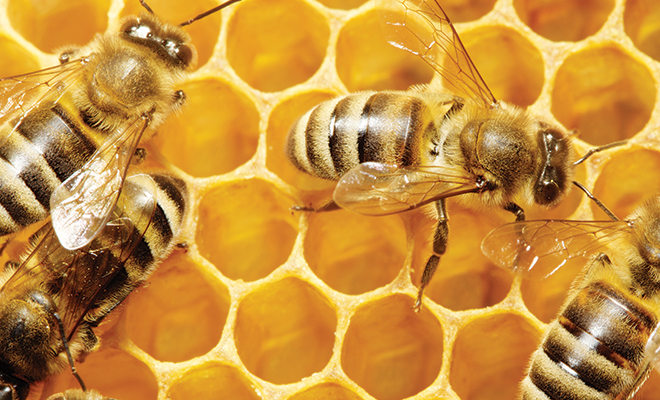
Honey Bees: An Endangered Species
June is that time of year when we’re breaking out of our winter shells and scurrying about with outdoor and indoor projects. At the same time, our buzzy little friends are busy too. Blossoms are opening, brimming with pollen and food for bees. Our winged friends are not only nourishing themselves, but bees play a critical role in keeping us fed.
According to the USDA, three-fourths of the world’s flowering plants and about 35 percent of the world’s food crops depend on animal pollinators to reproduce. More than 3,500 species of native bees help increase crop yields. One of every three bites of food in the United States depends on honey bees and other pollinators such as butterflies and moths, birds and bats, and beetles and other insects. Honey bees pollinate $15 billion worth of crops each year, including more than 130 fruits and vegetables. Managed honey bees are important to American agriculture because they pollinate a wide variety of crops, contributing to food diversity, security and profitability. In fact, the USDA classifies honey bees as “livestock” because of the contribution they make to our food supply.
Unfortunately, these hard workers are also in danger. During the past 50 years, the number of managed honey bees has drastically fallen. Each winter since 2006, about 30 percent of beehives collapsed because of disease, parasites, poor nutrition, pesticide exposure and other issues.
Rachael and Erik Messner are in the sweet business of honey. They’re beekeepers involved with the Midwestern Beekeeper Association and proudly wear the titles of bee educators. They warn of the debilitating environment for bees, which can be attributed in large part to humans. “Climate change is a serious factor for bees on several fronts. As it gets hotter, the period of non-blooming for plants and trees will extend and shorten the bees’ access to food,” remarked Erik. “In 2016, a study from the Royal Society, the world’s oldest scientific academy in continuous existence, found that when carbon dioxide increases in the atmosphere, it reduces the protein content in pollen by 33 percent. Bees have to work 50 percent harder to maintain the same levels of protein in their diets. This impacts their immune system, which makes it difficult for the bees to fight off pesticides and herbicides and maintain their overall health.”
The pesticides and herbicides we use on yards and crops are wiping out bees. These neonicotinoids attack an insect’s nervous system, wiping out honey bees across the globe in what’s described as an epidemic. However, Rachael points out that fungicides, chemicals used to destroy or hinder the growth of fungus spores, can be even more lethal. “Bees use microbes in their gut to help them break down food, but bad actors such as fungicides can end up on that food they consume. The fungicide kills the microflora in their gut and negatively impacts them,” shared Rachael. “Fungicides are so deadly they’re linked to colony death more than herbicides and pesticides.”
Not only can you curtail your use of chemicals, you can plant flowers and trees to feed bees. Pots on patios brimming with bee-friendly flora or a yard filled with blossoming native plants can have a positive impact. “Not all flowers will be nectar sources for bees,” noted Rachael. “Trees have many blooms on them and nectar that’s available. Plant milkweed, borage and clover. Dandelions are critical sources of food for bees when there’s not enough pollen to go around.”
Another way to enhance our bee population is to support local honey producers by buying their products. “Seventy-five percent of the honey we consume in the U.S. is imported. Many times, it’s mislabeled and cut with syrups. Some have been found to have heavy metals in them. In fact, honey is the third most fraudulent food in the U.S.,” advised Rachael. “Support your local honey producers by buying their products. Also, consider buying organic foods to help support farms that don’t use harmful chemicals.”
While housing a honey bee colony at home may come to mind, Erik cautions homeowners to ensure they understand all of the ramifications before winging it. “For $500 to $1,000 you can have a beehive in your backyard, but keeping bees is hard work so research to ensure you know what you’re doing. Keeping bees is more complicated than having a pet, and some cities don’t allow it,” reported Erik. “What bees are lacking is not a home; bees can find homes in all sorts of places. If you really want to help, stop using pesticides and herbicides, purchase organic foods and buy local honey.”
“Remember, we depend on bees for pollinating a third of our food supply and that’s important,” added Rachael. “Bees are having a hard time right now and they’re struggling worldwide. People should make the right decisions and the right lifestyle choices to help our bees.” ■
Sources: aphis.usda.gov.







